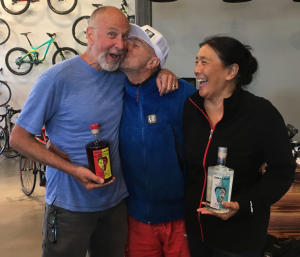A regular feature at Slowtwitch Road Shows are "Express Fits," which are my versions of speed chess. Last Saturday I fit 8 people at Bonzai Sports in metro Washington DC. A typical full day of fitting (a crammed day of fitting) would be 4 people. Did I achieve nothing other than 8 half-way fits instead of 3 or 4 good fits? You decide.

Just below is a gentleman looking for a fine-tune of his existing position. This is a 33 second video consisting of him riding in the position he and I conspired to make aboard Bonzai's Purely Custom fit bike, then he hops off and on his own bike aboard a Wahoo Kickr.
Here's what I don't like about the position he rode in on: too stretched, and he's seated rearward. The position he's in on the fit bike is slightly lower in front, but the big difference is the distance from the saddle forward to the aerobars: much tighter now. It's a mix of hips forward and aerobars slightly back (and slightly lower).
This rider has no problem riding in a fairly aggressive position (aggressive in my parlance meaning forward and low in front). Out of the 8 Express Fits on the day 6 of them needed to be coaxed slightly lower or they ended up about the same, but 2 were either coaxed higher, or were convinced out of positions that were over-low.
"Everybody is different." Okay. We hear that. Yes. But only on the margins. All of modern science and medicine, all of coaching, operates on the opposite principle, that in the main "Everybody is the same." Sameness trumps Difference. All the riders above and below exhibit micro-differences but "macro-samenesses".
Whenever I'm the fitter I always ask the rider to spend some reasonable amount of time looking forward, to make sure the position is sustainable. This won't always show in 7 seconds of a video, and that's the case in the video above. One of my broken collarbones is courtesy of my spending too much time looking down instead of forward in a race.
Without delving into personal details of subjects I think I'm on solid ground just in saying the subject above is a banker. Bankers can ride pro positions too, or at least positions that are close to pro, and could be pro if the banker didn't bank, and spent all day training instead.
However, positions like this cannot be maintained unless "contact points" are optimized: you need to have a comfortable saddle, comfortable armrests, comfortable extension shapes (and lengths), comfortable apparel. Without this, good luck every ending up in positions like these. That's why every fit studio needs to be supplied with a wide selection of the right saddles and aerobars, and a way to quickly change between them.
And finally this is from a fit session the week before, at Rocklin Endurance just north of Sacramento. We had 2 fit bikes going and in the background is Ian Murray, our head instructor at our F.I.S.T. Workshops. We pushed through maybe a dozen Express Fits that day? This is one of them.
I include the above because I love her position. We had to move through a number of saddles. There's a device under Ian's hand, on the other fit bike, that allows me to change a saddle in about 5 seconds, without the rider dismounting. If you want to know how to execute a fit in 45 minutes instead of 2-and-a-half hours, if your fitter invested in equipment that speeds up the process, the fit doesn't need to take as long!
I believe I've written here before about the concept of "drivers." Whether you are a bike designer, or a fitter, or a coach, there are metrics or imperatives or axioms that drive what you do. You could extend this to lawyers or accountants, and probably to doctors and caregivers. What drives the process? Does your lawyer want to win a litigation? Or prevent a litigation? Does your accountant want to help you to aggressively pay the lowest possible tax? Or to audit-proof your return and resist red flags? Just so, a fitter has drivers. What drove the fits above?
There are several imperatives that drive my fit sessions but quite near the top are the comfort and power produced by the rider, as determined by the rider. Each of the fits above are comfortable and powerful (presumably over the long haul), say the subjects. So, yes, AGers, even MOPers, probably even some BOPers, can ride positions in the same neighborhood as the pros ride. Why? Because pros are pros because of the engine, not the chassis, and because pros need comfort just as much as everyone else.



